Junkang Wu
Quantile Advantage Estimation for Entropy-Safe Reasoning
Sep 26, 2025Abstract:Reinforcement Learning with Verifiable Rewards (RLVR) strengthens LLM reasoning, but training often oscillates between {entropy collapse} and {entropy explosion}. We trace both hazards to the mean baseline used in value-free RL (e.g., GRPO and DAPO), which improperly penalizes negative-advantage samples under reward outliers. We propose {Quantile Advantage Estimation} (QAE), replacing the mean with a group-wise K-quantile baseline. QAE induces a response-level, two-regime gate: on hard queries (p <= 1 - K) it reinforces rare successes, while on easy queries (p > 1 - K) it targets remaining failures. Under first-order softmax updates, we prove {two-sided entropy safety}, giving lower and upper bounds on one-step entropy change that curb explosion and prevent collapse. Empirically, this minimal modification stabilizes entropy, sparsifies credit assignment (with tuned K, roughly 80% of responses receive zero advantage), and yields sustained pass@1 gains on Qwen3-8B/14B-Base across AIME 2024/2025 and AMC 2023. These results identify {baseline design} -- rather than token-level heuristics -- as the primary mechanism for scaling RLVR.
AdaViP: Aligning Multi-modal LLMs via Adaptive Vision-enhanced Preference Optimization
Apr 22, 2025Abstract:Preference alignment through Direct Preference Optimization (DPO) has demonstrated significant effectiveness in aligning multimodal large language models (MLLMs) with human preferences. However, existing methods focus primarily on language preferences while neglecting the critical visual context. In this paper, we propose an Adaptive Vision-enhanced Preference optimization (AdaViP) that addresses these limitations through two key innovations: (1) vision-based preference pair construction, which integrates multiple visual foundation models to strategically remove key visual elements from the image, enhancing MLLMs' sensitivity to visual details; and (2) adaptive preference optimization that dynamically balances vision- and language-based preferences for more accurate alignment. Extensive evaluations across different benchmarks demonstrate our effectiveness. Notably, our AdaViP-7B achieves 93.7% and 96.4% reductions in response-level and mentioned-level hallucination respectively on the Object HalBench, significantly outperforming current state-of-the-art methods.
Aligning Multimodal LLM with Human Preference: A Survey
Mar 18, 2025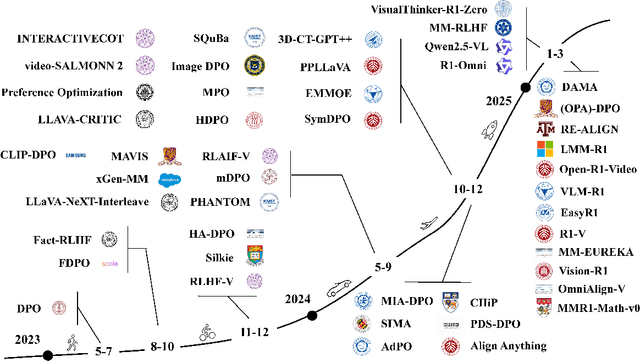
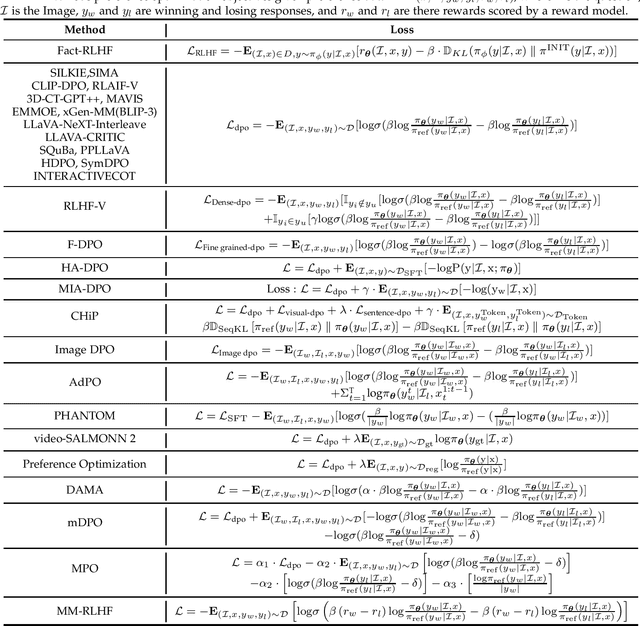
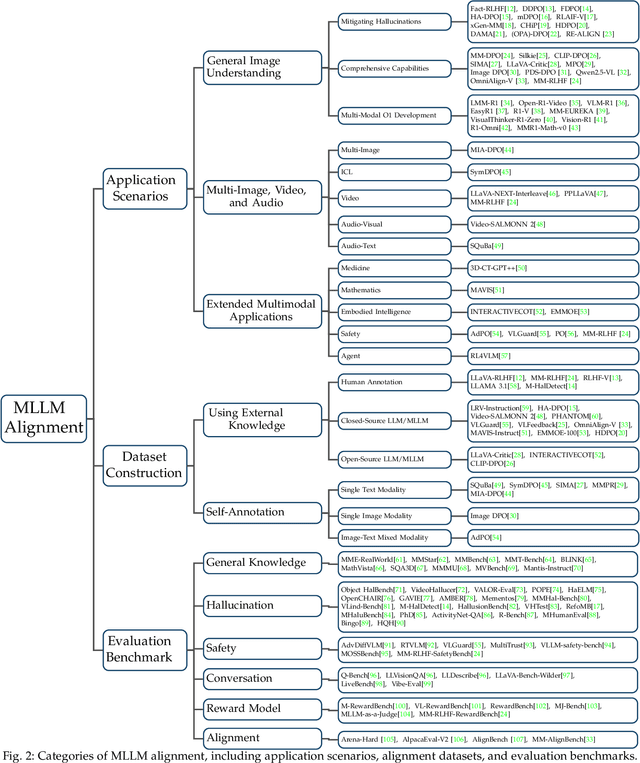
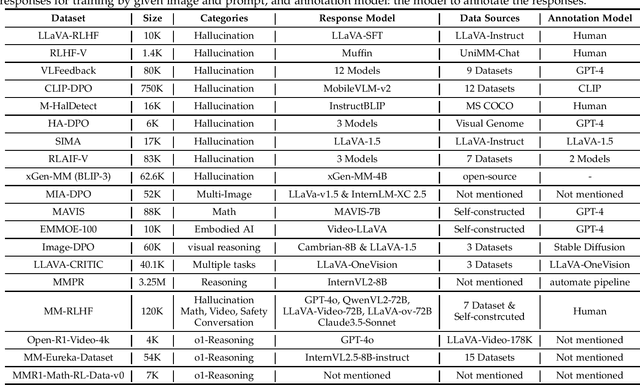
Abstract:Large language models (LLMs) can handle a wide variety of general tasks with simple prompts, without the need for task-specific training. Multimodal Large Language Models (MLLMs), built upon LLMs, have demonstrated impressive potential in tackling complex tasks involving visual, auditory, and textual data. However, critical issues related to truthfulness, safety, o1-like reasoning, and alignment with human preference remain insufficiently addressed. This gap has spurred the emergence of various alignment algorithms, each targeting different application scenarios and optimization goals. Recent studies have shown that alignment algorithms are a powerful approach to resolving the aforementioned challenges. In this paper, we aim to provide a comprehensive and systematic review of alignment algorithms for MLLMs. Specifically, we explore four key aspects: (1) the application scenarios covered by alignment algorithms, including general image understanding, multi-image, video, and audio, and extended multimodal applications; (2) the core factors in constructing alignment datasets, including data sources, model responses, and preference annotations; (3) the benchmarks used to evaluate alignment algorithms; and (4) a discussion of potential future directions for the development of alignment algorithms. This work seeks to help researchers organize current advancements in the field and inspire better alignment methods. The project page of this paper is available at https://github.com/BradyFU/Awesome-Multimodal-Large-Language-Models/tree/Alignment.
RePO: ReLU-based Preference Optimization
Mar 10, 2025Abstract:Aligning large language models (LLMs) with human preferences is critical for real-world deployment, yet existing methods like RLHF face computational and stability challenges. While DPO establishes an offline paradigm with single hyperparameter $\beta$, subsequent methods like SimPO reintroduce complexity through dual parameters ($\beta$, $\gamma$). We propose {ReLU-based Preference Optimization (RePO)}, a streamlined algorithm that eliminates $\beta$ via two advances: (1) retaining SimPO's reference-free margins but removing $\beta$ through gradient analysis, and (2) adopting a ReLU-based max-margin loss that naturally filters trivial pairs. Theoretically, RePO is characterized as SimPO's limiting case ($\beta \to \infty$), where the logistic weighting collapses to binary thresholding, forming a convex envelope of the 0-1 loss. Empirical results on AlpacaEval 2 and Arena-Hard show that RePO outperforms DPO and SimPO across multiple base models, requiring only one hyperparameter to tune.
DAMO: Data- and Model-aware Alignment of Multi-modal LLMs
Feb 04, 2025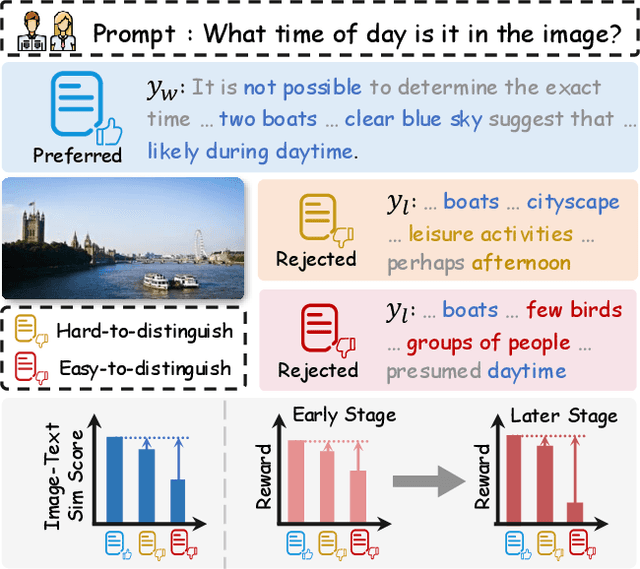
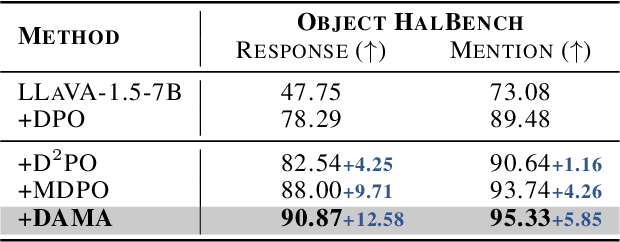


Abstract:Direct Preference Optimization (DPO) has shown effectiveness in aligning multi-modal large language models (MLLM) with human preferences. However, existing methods exhibit an imbalanced responsiveness to the data of varying hardness, tending to overfit on the easy-to-distinguish data while underfitting on the hard-to-distinguish data. In this paper, we propose Data- and Model-aware DPO (DAMO) to dynamically adjust the optimization process from two key aspects: (1) a data-aware strategy that incorporates data hardness, and (2) a model-aware strategy that integrates real-time model responses. By combining the two strategies, DAMO enables the model to effectively adapt to data with varying levels of hardness. Extensive experiments on five benchmarks demonstrate that DAMO not only significantly enhances the trustworthiness, but also improves the effectiveness over general tasks. For instance, on the Object HalBench, our DAMO-7B reduces response-level and mentioned-level hallucination by 90.0% and 95.3%, respectively, surpassing the performance of GPT-4V.
$α$-DPO: Adaptive Reward Margin is What Direct Preference Optimization Needs
Oct 14, 2024



Abstract:Aligning large language models (LLMs) with human values and intentions is crucial for their utility, honesty, and safety. Reinforcement learning from human feedback (RLHF) is a popular approach to achieve this alignment, but it faces challenges in computational efficiency and training stability. Recent methods like Direct Preference Optimization (DPO) and Simple Preference Optimization (SimPO) have proposed offline alternatives to RLHF, simplifying the process by reparameterizing the reward function. However, DPO depends on a potentially suboptimal reference model, and SimPO's assumption of a fixed target reward margin may lead to suboptimal decisions in diverse data settings. In this work, we propose $\alpha$-DPO, an adaptive preference optimization algorithm designed to address these limitations by introducing a dynamic reward margin. Specifically, $\alpha$-DPO employs an adaptive preference distribution, balancing the policy model and the reference model to achieve personalized reward margins. We provide theoretical guarantees for $\alpha$-DPO, demonstrating its effectiveness as a surrogate optimization objective and its ability to balance alignment and diversity through KL divergence control. Empirical evaluations on AlpacaEval 2 and Arena-Hard show that $\alpha$-DPO consistently outperforms DPO and SimPO across various model settings, establishing it as a robust approach for fine-tuning LLMs. Our method achieves significant improvements in win rates, highlighting its potential as a powerful tool for LLM alignment. The code is available at https://github.com/junkangwu/alpha-DPO
$β$-DPO: Direct Preference Optimization with Dynamic $β$
Jul 11, 2024Abstract:Direct Preference Optimization (DPO) has emerged as a compelling approach for training Large Language Models (LLMs) to adhere to human preferences. However, the performance of DPO is sensitive to the fine-tuning of its trade-off parameter $\beta$, as well as to the quality of the preference data. We analyze the impact of $\beta$ and data quality on DPO, uncovering that optimal $\beta$ values vary with the informativeness of pairwise data. Addressing the limitations of static $\beta$ values, we introduce a novel framework that dynamically calibrates $\beta$ at the batch level, informed by data quality considerations. Additionally, our method incorporates $\beta$-guided data filtering to safeguard against the influence of outliers. Through empirical evaluation, we demonstrate that our dynamic $\beta$ adjustment technique significantly improves DPO's performance across a range of models and datasets, offering a more robust and adaptable training paradigm for aligning LLMs with human feedback. The code is available at \url{https://github.com/junkangwu/beta-DPO}.
Towards Robust Alignment of Language Models: Distributionally Robustifying Direct Preference Optimization
Jul 10, 2024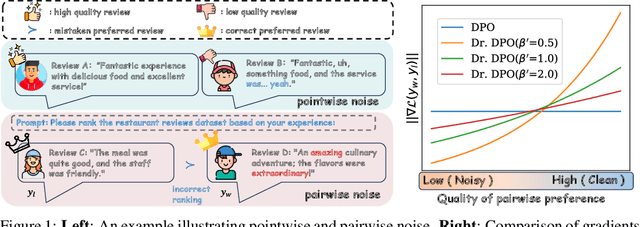

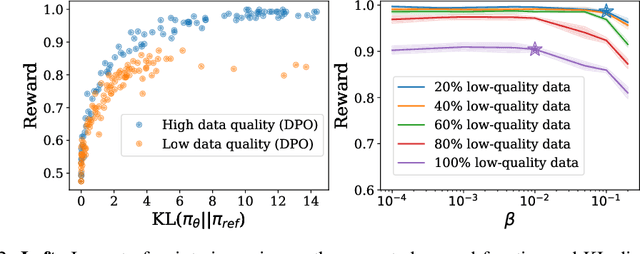
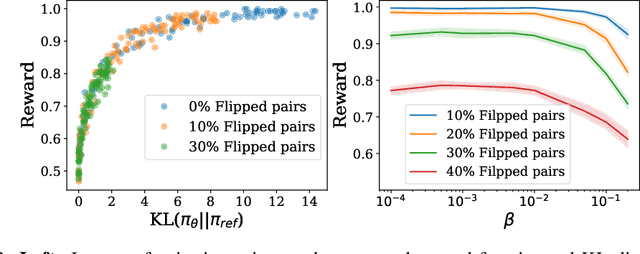
Abstract:This study addresses the challenge of noise in training datasets for Direct Preference Optimization (DPO), a method for aligning Large Language Models (LLMs) with human preferences. We categorize noise into pointwise noise, which includes low-quality data points, and pairwise noise, which encompasses erroneous data pair associations that affect preference rankings. Utilizing Distributionally Robust Optimization (DRO), we enhance DPO's resilience to these types of noise. Our theoretical insights reveal that DPO inherently embeds DRO principles, conferring robustness to pointwise noise, with the regularization coefficient $\beta$ playing a critical role in its noise resistance. Extending this framework, we introduce Distributionally Robustifying DPO (Dr. DPO), which integrates pairwise robustness by optimizing against worst-case pairwise scenarios. The novel hyperparameter $\beta'$ in Dr. DPO allows for fine-tuned control over data pair reliability, providing a strategic balance between exploration and exploitation in noisy training environments. Empirical evaluations demonstrate that Dr. DPO substantially improves the quality of generated text and response accuracy in preference datasets, showcasing enhanced performance in both noisy and noise-free settings. The code is available at https://github.com/junkangwu/Dr_DPO.
Direct Multi-Turn Preference Optimization for Language Agents
Jun 25, 2024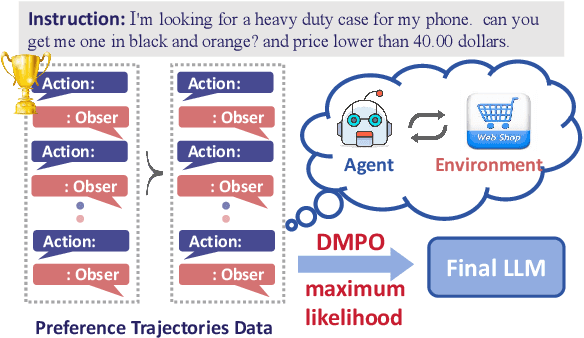
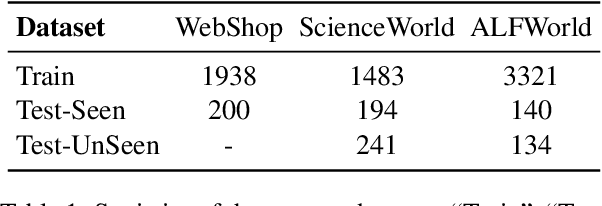
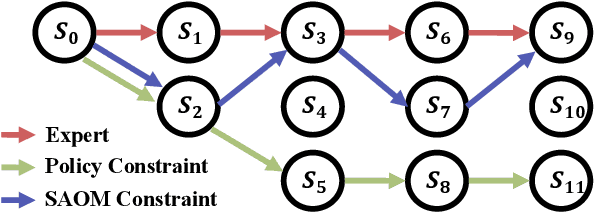

Abstract:Adapting Large Language Models (LLMs) for agent tasks is critical in developing language agents. Direct Preference Optimization (DPO) is a promising technique for this adaptation with the alleviation of compounding errors, offering a means to directly optimize Reinforcement Learning (RL) objectives. However, applying DPO to multi-turn tasks presents challenges due to the inability to cancel the partition function. Overcoming this obstacle involves making the partition function independent of the current state and addressing length disparities between preferred and dis-preferred trajectories. In this light, we replace the policy constraint with the state-action occupancy measure constraint in the RL objective and add length normalization to the Bradley-Terry model, yielding a novel loss function named DMPO for multi-turn agent tasks with theoretical explanations. Extensive experiments on three multi-turn agent task datasets confirm the effectiveness and superiority of the DMPO loss.
Lower-Left Partial AUC: An Effective and Efficient Optimization Metric for Recommendation
Feb 29, 2024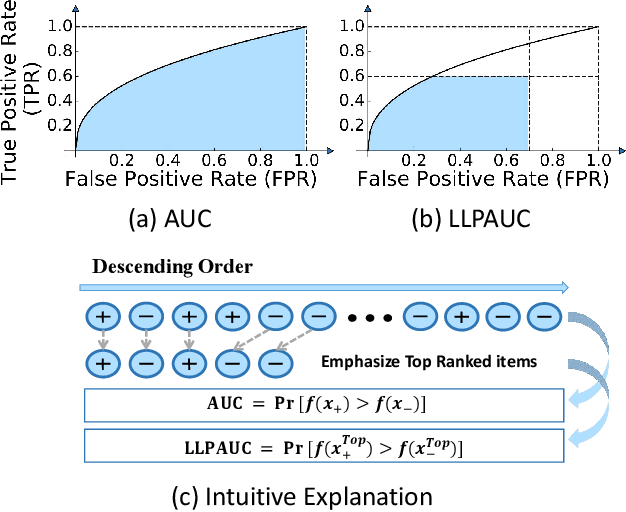
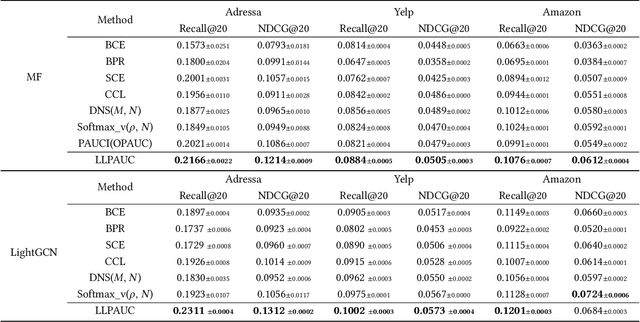

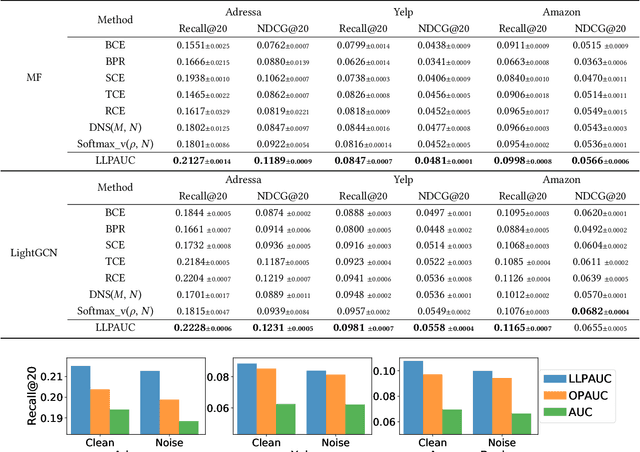
Abstract:Optimization metrics are crucial for building recommendation systems at scale. However, an effective and efficient metric for practical use remains elusive. While Top-K ranking metrics are the gold standard for optimization, they suffer from significant computational overhead. Alternatively, the more efficient accuracy and AUC metrics often fall short of capturing the true targets of recommendation tasks, leading to suboptimal performance. To overcome this dilemma, we propose a new optimization metric, Lower-Left Partial AUC (LLPAUC), which is computationally efficient like AUC but strongly correlates with Top-K ranking metrics. Compared to AUC, LLPAUC considers only the partial area under the ROC curve in the Lower-Left corner to push the optimization focus on Top-K. We provide theoretical validation of the correlation between LLPAUC and Top-K ranking metrics and demonstrate its robustness to noisy user feedback. We further design an efficient point-wise recommendation loss to maximize LLPAUC and evaluate it on three datasets, validating its effectiveness and robustness.
 Add to Chrome
Add to Chrome Add to Firefox
Add to Firefox Add to Edge
Add to Edge